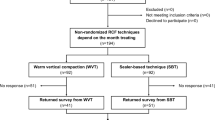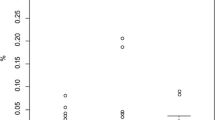Summary
Epiphany/Resilon™ and GuttaFlow® are newly developed methods for obturation of the root canal system. Epiphany/Resilon™ is a thermoplastic, synthetic polymer-based root canal filling material which enables the bonding to the dentin root canal wall during root canal obturation. GuttaFlow® is a cold flowable filling system for the obturation of root canals, combining sealer and gutta-percha in one product. The purpose of this study was to assess the leakage of the Epiphany/Resilon™ or GuttaFlow® root canal filling compared with lateral condensation of gutta-percha. For this study were used 45 human extracted teeth, chemo mechanically prepared, divided into three groups and obturated with gutta-percha/AH Plus, Epiphany/Resilon™ and GuttaFlow®. For dye penetration all teeth were centrifuged for three minutes at 30 g in 2% methylene blue and dissolved in 65% nitric acid for 3 days. The extracted methylene blue was determined with Photometer. Root Canal fillings with Epiphany/Resilon™ showed less dye penetration than lateral condensation of gutta-percha and GuttaFlow®. Epiphany/Resilon™ is ideally suited as a root canal filling material.
Zusammenfassung
Epiphany/Resilon™ und GuttaFlow® sind neu entwickelte Methoden zur Obturation des Wurzelkanalsystems. Epiphany/Resilon™ ist ein thermoplastisches, synthetisches Wurzelfüllungsmaterial auf Polymerbasis, mit dem eine Haftung am Dentin der Wurzelkanalwand ermöglicht werden soll. GuttaFlow® ist ein Kaltfüllsystem für Wurzelkanäle, welches Sealer und Guttapercha in einem Produkt vereint. Es wurde untersucht, ob mit Epiphany/Resilon™ oder GuttaFlow® eine dichtere Wurzelkanalfüllung erzielt werden kann als mit der lateralen Kondensation von Guttapercha. Für diese Studie wurden 45 extrahierte menschliche Zähne verwendet, welche zuerst alle chemomechanisch aufbereitet wurden und anschließend in drei Gruppen aufgeteilt und mit folgenden Materialien gefüllt: Guttapercha/AH Plus, Epiphany/Resilon™ und GuttaFlow®. Beim Farbstoffpenetrationstest wurden alle Zähne bei 400 U/min 3 Min. lang mit 1 ml 2 % Methylenblau zentrifugiert und 3 Tage in Salpetersäure 65 % gelegt, um sie aufzulösen. Danach wurde die Menge des in Lösung gegangenen Farbstoffs im Photometer bestimmt. Wurzelkanalfüllungen mit Epiphany/Resilon™ zeigten weniger Farbstoffpenetration als Wurzelkanalfüllungen mit lateraler Kondensation von Guttapercha und GuttaFlow®. Epiphany/Resilon™ ist hervorragend als Wurzelkanalfüllmaterial geeignet.
Similar content being viewed by others
Literatur
Hovland EJ, Dumsha TC. Leakage evaluation in vitro of the root canal sealer Sealapex. Int Endod J, 18: 179–182, 1985
Shipper G, Trope M. In vitro microbial leakage of endodontically treated teeth using new and standard obturation techniques. J Endod, 30: 154–158, 2004
Aptekar A, Ginnan K. Comparative analysis of microleakage and seal for 2 obturation materials: Resilon/Epiphany and gutta-percha. J Can Dent Assoc, 72: 245, 2006
Shipper G, Teixeira FB, Arnold RA, et al. Periapical inflammation after coronal microbial inoculation of dog roots filled with gutta-percha or Resilon. J Endod, 31: 91–96, 2005
Tay FR, Loushine RJ, Weller RN, et al. Ultrastructural evaluation of the apical seal in roots filled with a polycaprolactone-based root canal filling material. J Endod, 31: 514–549, 2005
Pitout E, Oberholzer TG. Leakage of teeth root filled with GuttaFlow and a single GP cone compared to lateral condensation and warm vertical condensation. SADJ, 64: 106–108, 2009
ElAyouti A, Kiefner P, Hecker H, et al. Homogeneity and adaption of endodontic fillings in root canals with enlarged apical preparation. Oral Surg, 108: 141–146, 2009
Hülsmann M, Heckendorff M, Lennon A. Chelating agents in root canal treatment: mode of action and indications for their use. Int Endod J, 36: 810–813, 2003
Shemesh H, Wu MK, Wesselink PR. Leakage along apical root fillings with or without smear layer using two different leakage models: a two-month longitudinal ex vivo study. Int Endod J, 39: 968–976, 2006
Camps J, Pashley D. Reliability of the Dye Penetration Studies. J Endod, 29: 592–594, 2003
Torabinejad M, Skobe Z, Trombly PL, et al. Scanning electron microscopic study of root canal obturation using thermoplasticized gutta-percha. J Endod, 4: 245–250, 1978
Nielsen TH. Sealing ability of chelate root filling cements: the triple CA-test using compressed air. Part 3. J Endod, 6: 835–841, 1980
Barthel CR, Moshonov J, Shuping G, et al. Bacterial leakage versus dye leakage in obturated root canals. J Endod, 32: 370–375, 1999
Gilbert SD, Witherspoon DE, Berry CV. Coronal leakage following three obturation techniques. Int Endod J, 34: 293–299, 2001
Miletić I, Prpić-Mehicić G, Marsan T, et al. Bacterial and fungal microleakage of AH26 and AH Plus root canal sealers. Int Endod J, 35: 428–432, 2002
Timpawat S, Amornchat C, Trisuwan WR. Bacterial coronal leakage after obturation with three root canal sealers. J Endod, 27: 36–39, 2001
Torabinejad M, Ung B, Kettering JD. In vitro bacterial penetration of coronally unsealed endodontically treated teeth. J Endod, 16: 566–569, 1990
Kapsimalis P, Evans R. Sealing properties of endodontic filling materials using radioactive polar and nonpolar isotopes. Oral Surg Oral Med Oral Pathol, 22: 386–393, 1966
Beatty RG, Zakariasen KL. Apical leakage associated with three obturation techniques in large and small root canals. Int Endod J, 17: 67–72, 1984
Dalat DM, Onal B. Apical leakage of a new glass ionomer root canal sealer. J Endod, 24: 161–163, 1998
Ishimura H, Yoshioka T, Suda H. Sealing ability of new adhesive root canal filling materials measured by new dye penetration method. Dent Mater J, 26: 290–295, 2007
Miletić I, Anić I, Pezelij-Ribarić S, et al. Leakage of five root-canal sealers. Int Endod J, 32: 415–418, 1999
Pommel L, About I, Pashley D, et al. Apical leakage of four endodontic sealers. J Endod, 29: 208–210, 2003
Shemesh H, Souza EM, Wu MK, et al. Glucose reactivity with filling materials as a limitation for using the glucose leakage model. Int Endod J, 41: 869–872, 2008
Wu MK, De Gee AJ, Wesselink PR. Fluid transport and dye penetration along root canal fillings. Int Endod J, 27: 233–238, 1994
Matloff IR, Jensen JR, Singer L, et al. A comparison of methods used in root canal sealability studies. Oral Surg, 53: 203–208, 1982
Eldeniz AU, Ørstavik D. A laboratory assessment of coronal bacterial leakage in root canals filled with new and conventional sealers. Int Endod J, 42: 303–312, 2009
Teixeira FB, Teixeira EC, Thompson J, et al. Dentinal bonding reaches the root canal system. J Esthet Restor Dent, 16: 348–354, 2004
Pasqualini D, Scotti N, Mollo L, et al. Microbial leakage of gutta-percha and Resilon root canal filling material: a comparative study using a new homogeneous assay for sequence detection. J Biomater Appl, 22: 337–352, 2008
Baumgartner G, Zehnder M, Paque F. Enterococcus faecalis type strain leakage through root canals filled with Gutta-percha/AH plus or Resilon/Epiphany. J Endod, 33: 45–47, 2007
De Deus G, Brandao MC, Fidel RA, et al. The sealing ability of GuttaFlow trade mark in oval-shaped canals: an ex vivo study using a polymicrobial leakage model. Int Endod J, 40: 794–799, 2007
Elayouti A, Achleithner C, Löst C, et al. Homogeneity and adaptation of a new gutta percha paste to root canal walls. J Endod, 31: 687–690, 2005
Ozok AR, van der Sluis LW, Wu MK, et al. Sealing ability of a new polydimethylsiloxane-based root canal filling material. J Endod, 34: 204–207, 2008
Kontakiotis EG, Tzanetakis GN, Loizides AL. A 12-month longitudinal in vitro leakage study on a new silicon-based root canal filling material (Gutta-Flow). Oral Surg, 103: 854–859, 2007
Author information
Authors and Affiliations
Corresponding author
Rights and permissions
About this article
Cite this article
Kqiku, L., Miletic, I., Gruber, H. et al. Dichtigkeit von Wurzelkanalfüllungen mit GuttaFlow® und Resilon™ im Vergleich zur lateralen Kondensation. Wien Med Wochenschr 160, 230–234 (2010). https://doi.org/10.1007/s10354-010-0790-5
Received:
Accepted:
Issue Date:
DOI: https://doi.org/10.1007/s10354-010-0790-5




